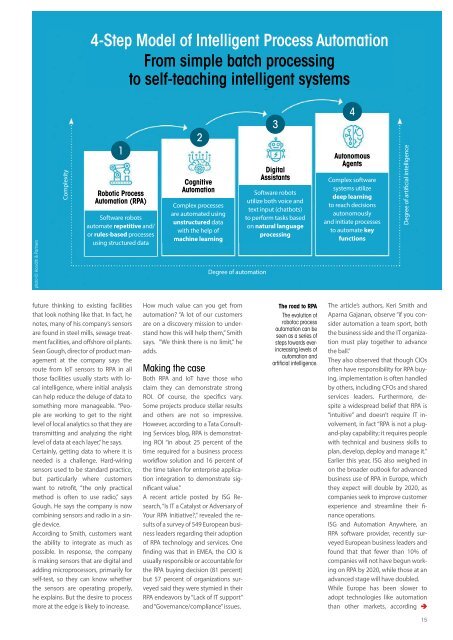Smart Industry 2/2018
Smart Industry 2/2018 - The IoT Business Magazine - powered by Avnet Silica
Smart Industry 2/2018 - The IoT Business Magazine - powered by Avnet Silica
Create successful ePaper yourself
Turn your PDF publications into a flip-book with our unique Google optimized e-Paper software.
4-Step Model of Intelligent Process Automation<br />
From simple batch processing<br />
to self-teaching intelligent systems<br />
photo ©: Horváth & Partners<br />
Complexity<br />
1<br />
Robotic Process<br />
Automation (RPA)<br />
Software robots<br />
automate repetitive and/<br />
or rules-based processes<br />
using structured data<br />
2<br />
Cognitive<br />
Automation<br />
Complex processes<br />
are automated using<br />
unstructured data<br />
with the help of<br />
machine learning<br />
Degree of automation<br />
3<br />
Digital<br />
Assistants<br />
Software robots<br />
utilize both voice and<br />
text input (chatbots)<br />
to perform tasks based<br />
on natural language<br />
processing<br />
4<br />
Autonomous<br />
Agents<br />
Complex software<br />
systems utilize<br />
deep learning<br />
to reach decisions<br />
autonomously<br />
and initiate processes<br />
to automate key<br />
functions<br />
Degree of artificial intelligence<br />
future thinking to existing facilities<br />
that look nothing like that. In fact, he<br />
notes, many of his company’s sensors<br />
are found in steel mills, sewage treatment<br />
facilities, and offshore oil plants.<br />
Sean Gough, director of product management<br />
at the company says the<br />
route from IoT sensors to RPA in all<br />
those facilities usually starts with local<br />
intelligence, where initial analysis<br />
can help reduce the deluge of data to<br />
something more manageable. “People<br />
are working to get to the right<br />
level of local analytics so that they are<br />
transmitting and analyzing the right<br />
level of data at each layer,” he says.<br />
Certainly, getting data to where it is<br />
needed is a challenge. Hard-wiring<br />
sensors used to be standard practice,<br />
but particularly where customers<br />
want to retrofit, “the only practical<br />
method is often to use radio,” says<br />
Gough. He says the company is now<br />
combining sensors and radio in a single<br />
device.<br />
According to Smith, customers want<br />
the ability to integrate as much as<br />
possible. In response, the company<br />
is making sensors that are digital and<br />
adding microprocessors, primarily for<br />
self-test, so they can know whether<br />
the sensors are operating properly,<br />
he explains. But the desire to process<br />
more at the edge is likely to increase.<br />
How much value can you get from<br />
automation? “A lot of our customers<br />
are on a discovery mission to understand<br />
how this will help them,” Smith<br />
says. “We think there is no limit,” he<br />
adds.<br />
Making the case<br />
Both RPA and IoT have those who<br />
claim they can demonstrate strong<br />
ROI. Of course, the specifics vary.<br />
Some projects produce stellar results<br />
and others are not so impressive.<br />
However, according to a Tata Consulting<br />
Services blog, RPA is demonstrating<br />
ROI “in about 25 percent of the<br />
time required for a business process<br />
workflow solution and 16 percent of<br />
the time taken for enterprise application<br />
integration to demonstrate significant<br />
value.”<br />
A recent article posted by ISG Research,<br />
“Is IT a Catalyst or Adversary of<br />
Your RPA Initiative?,” revealed the results<br />
of a survey of 549 European business<br />
leaders regarding their adoption<br />
of RPA technology and services. One<br />
finding was that in EMEA, the CIO is<br />
usually responsible or accountable for<br />
the RPA buying decision (81 percent)<br />
but 57 percent of organizations surveyed<br />
said they were stymied in their<br />
RPA endeavors by “Lack of IT support”<br />
and “Governance/compliance” issues.<br />
The road to RPA<br />
The evolution of<br />
robotoc process<br />
automation can be<br />
seen as a series of<br />
steps towards everincreasing<br />
levels of<br />
automation and<br />
artificial intelligence.<br />
The article’s authors, Keri Smith and<br />
Aparna Gajanan, observe “if you consider<br />
automation a team sport, both<br />
the business side and the IT organization<br />
must play together to advance<br />
the ball.”<br />
They also observed that though CIOs<br />
often have responsibility for RPA buying,<br />
implementation is often handled<br />
by others, including CFOs and shared<br />
services leaders. Furthermore, despite<br />
a widespread belief that RPA is<br />
“intuitive” and doesn’t require IT involvement,<br />
in fact “RPA is not a plugand-play<br />
capability; it requires people<br />
with technical and business skills to<br />
plan, develop, deploy and manage it.”<br />
Earlier this year, ISG also weighed in<br />
on the broader outlook for advanced<br />
business use of RPA in Europe, which<br />
they expect will double by 2020, as<br />
companies seek to improve customer<br />
experience and streamline their finance<br />
operations.<br />
ISG and Automation Anywhere, an<br />
RPA software provider, recently surveyed<br />
European business leaders and<br />
found that that fewer than 10% of<br />
companies will not have begun working<br />
on RPA by 2020, while those at an<br />
advanced stage will have doubled.<br />
While Europe has been slower to<br />
adopt technologies like automation<br />
than other markets, according<br />
15
















